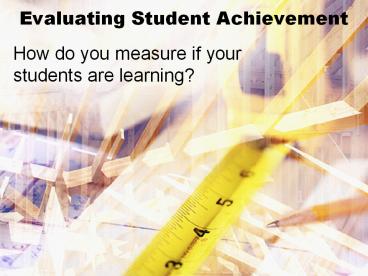Evaluating Student Achievement - PowerPoint PPT Presentation
Title:
Evaluating Student Achievement
Description:
Title: Evaluating Student Achievement Last modified by: jpeake Created Date: 6/7/2005 8:39:57 PM Document presentation format: On-screen Show Other titles – PowerPoint PPT presentation
Number of Views:151
Avg rating:3.0/5.0
Title: Evaluating Student Achievement
1
Evaluating Student Achievement
- How do you measure if your students are learning?
2
Question for you
- On a clean sheet of paper.
- Write down how measure student learning.
3
Sound Familiar
- I taught them, but the average grade was a 34 .
These students need to study harder. - "I don't need to understand this, I just need to
know an equation so I can pass the test."
4
Agenda
- Become familiar with the differences between
formative and summative evaluation.
5
Formative and Summative Assessment
- Formative Assessment is intertwined with your
teaching, it happens all the time. - Summative Assessment happens at the end of your
class and measures the students level of learning
at that specific moment in time.
6
Instruction and Evaluation
- Summative
- instruct instruct instruct instruct
- instruct instruct instruct evaluate
- Formative and Summative
- instruct evaluate instruct evaluate
- instruct evaluate instruct evaluate
- Instruction and evaluation happen at the same
time.
7
Your Evaluation Has to Match Your Objectives
What do your students need to learn?
Evaluation Make judgments
Synthesis Creates meaning
Analysis Break it down
Application Use a concept
Comprehension Understand meaning
Knowledge Recall or recite
8
Formative Assessment
- Formative Assessment lets the student know how
well they are grasping the material - Formative Assessment lets YOU identify the gaps
between what is being taught and what is being
learned.
9
Examples of Formative Assessment
- Just ask
- One minute paper
- Toughest point
- One sentence summary
- Application cards
- Mind Map
- Stop/Start/Continue
10
Examples of Summative Assessment
- Here a few summative evaluation techniques other
than test - Test
- Portfolios
- Product-Based
- Performance-Based
- Journals Learning Logs
- Quiz and Test
11
Advantages for the student
- Allows for a broad range of demonstration of
knowledge - Allows for legitimate self assessment.
- Individual strengths and abilities are
recognized. - Goals (objectives) are clearly stated in the
beginning of a unit of study.
12
Advantages for the Teacher
- Learning goals (objectives) are shared with
students before material is introduced. Students
know exactly what you want them to learn. - Tests all 6 levels of Blooms Taxonomy.
- Gives a clearer and broader picture of each
students abilities, strengths and knowledge.
13
Questions
14
(No Transcript)































